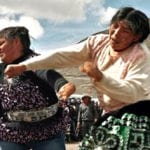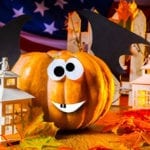 Mysteries
Mysteries  Mysteries
Mysteries  History
History 10 Surprising Stories About the Texas Rangers
 Humans
Humans 10 Philosophers Who Were Driven Mad by Their Own Theories
 Miscellaneous
Miscellaneous 10 Video-Game-Worthy Weapons and Armors from History
 Weird Stuff
Weird Stuff 10 Psychics Who Accurately Predicted Wartime Events
 The Arts
The Arts 10 Pieces of Art Inspired by a Broken Heart
 Health
Health 10 Science Fiction-Sounding New Medical Treatments
 History
History 10 Surprising Facts About the Father of Submarine Warfare
 Space
Space Ten Astonishing New Insights into Alien Worlds
 Weird Stuff
Weird Stuff 10 Bizarre Summer Solstice Rituals Still Practiced Today
 Mysteries
Mysteries Top 10 Haunting Facts About the Ghost Ship MV Alta
 History
History 10 Surprising Stories About the Texas Rangers
 Humans
Humans 10 Philosophers Who Were Driven Mad by Their Own Theories
Who's Behind Listverse?

Jamie Frater
Head Editor
Jamie founded Listverse due to an insatiable desire to share fascinating, obscure, and bizarre facts. He has been a guest speaker on numerous national radio and television stations and is a five time published author.
More About Us Miscellaneous
Miscellaneous 10 Video-Game-Worthy Weapons and Armors from History
 Weird Stuff
Weird Stuff 10 Psychics Who Accurately Predicted Wartime Events
 The Arts
The Arts 10 Pieces of Art Inspired by a Broken Heart
 Health
Health 10 Science Fiction-Sounding New Medical Treatments
 History
History 10 Surprising Facts About the Father of Submarine Warfare
 Space
Space Ten Astonishing New Insights into Alien Worlds
 Weird Stuff
Weird Stuff 10 Bizarre Summer Solstice Rituals Still Practiced Today
10 Traditions That Brighten the Festive Season
Different countries and cultures celebrate the festive season in diverse ways. For some, religious traditions are at the center of the festivities. For others, it’s all about gathering with family to enjoy a delicious meal and catch up with those who live far away. This in itself is also a tradition for many people around the world. Christmas carols have long been a staple of shopping centers during the holidays. Mistletoe is hung in strategic places by the romantic at heart. Well-thought-out holiday cards are sent and received. Children wake up on Christmas morning expecting to see wrapped gifts and cookie crumbs.
On this list are some of the more unique traditions that take place during the most wonderful time of the year.
Related: 10 Strange Stories About Our Odd Holiday Traditions And Beliefs
10 La Chocolatada
Each year, during Christmas time, companies and municipal governments in Peru band together to provide panettone (sweet bread) and countless cups of hot chocolate to disadvantaged communities within the country. They also collect toys and sweets to hand out to the children within these communities. The La Chocolatada event dates to the 1930s when it was used by politicians to win the approval of citizens. The tradition has since spread to other countries such as Spain, Bolivia, Argentina, and Ecuador.[1]
9 Starring
Thinking of Alaska brings to mind glaciers, moose, bears, and mountains. Here you will find more volcanoes than in any other state. You can explore the vast, unspoiled wilderness, gaze at the Northern Lights, and in certain parts, enjoy two months of constant sunlight.
When Christmas rolls around, the many Russian Orthodox families that have made Alaska their home celebrate with a tradition called Selaviq or Starring. This tradition was introduced to Alaska by Russian Orthodox priests after it began in the Carpathian Mountains during the 16th century. Following the Julian calendar, those who partake in the Starring tradition celebrate Christmas on January 7th. A procession carrying a large wooden star travels from house to house over several days. Those within the procession sing traditional folk songs and recite prayers. Along the way, food, gifts, and sweets are distributed while someone continuously spins the star. Starring symbolizes the journey of the wise men who followed the star of Bethlehem and ended up at the birthplace of Jesus Christ.[2]
8 A Guyana Christmas
Being in the Caribbean over the festive season means taking part in a variety of unique Christmas traditions. Guyana, which is part of the Anglophone Caribbean, celebrates the holidays by featuring masqueraders that dance from door to door wearing ghost costumes. Some of the most popular costumes include that of Mother Sally, who is a female figure on stilts wearing a long skirt, and the Cow, which is constructed to fit around the person wearing it.
Along with these festivities, delectable dishes are enjoyed, including black cake, garlic pork, pepperpot, and homemade ginger beer.[3]
7 Christmas Cakes
In Japan, Christmas goes hand-in-hand with over-the-top LED light displays in shopping centers, romantic dinners, and fried chicken.
And instead of indulging in fruitcake, people traditionally eat kurisumasu keeki while gathered with their loved ones. Kurisumasu keeki is a strawberry shortcake cake decorated with edible Christmas-themed ornaments. This tradition was carried over from the cream-covered cake tradition started by the Fujiya confectionery manufacturer, who encouraged people to “eat cake on “Christmas.”
For those who are not fond of strawberry flavoring, these cakes come in chocolate, fruit, and ice cream options. They can also be created in the shape of popular characters.[4]
6 A Hot Christmas
Christmas is generally associated with cold, snowy weather, hot chocolate or eggnog, and thick coats. Should you find yourself in Australia over the holiday period, however, you won’t experience any of that. Instead, you’ll most likely celebrate by lazing on the beach and knocking back (quite) a few cold drinks. Once you’re done roasting in the sun, you can enjoy a traditional cold seafood platter overflowing with prawns.
Before you retire for the night, you can play a game of cricket or dive into the pool for some heat-relieving fun. And if you’re still up for a party on Boxing Day, you can join Surfing Santa for a street party or a barbecue.[5]
5 Presépio
During the mid-13th century, the first Christmas crib was created in Italy. As the centuries passed, the concept caught on in other European countries. In modern times you can still find them in churches in England, fire stations in Portugal, and homes across the continent.
In family homes in Portugal, building a Christmas crib or presépio under the Christmas tree is still a cherished tradition. It includes the usual nativity elements, including the figures of the wise men, Joseph, Mary, and baby Jesus. Many of the presépios include a donkey and bull figure surrounding Jesus’ crib to keep Him warm. Some families include scenes of everyday life in their nativity setup. A stunning example of this is the Presépio Gigante in Vila Real de Santo António. This nativity scene includes beekeepers, a market, hunters, farmers, and much more.[6]
4 Pohutukawa
The Christmas tree is a holiday staple. Whether real or plastic, they usually take on the same shape and are highly recognizable worldwide. In New Zealand, the concept of the Christmas tree is kicked up a notch with the beautiful Pohutukawa tree. The tree is featured on Christmas decorations and gets a mention in several Christmas carols. In Māori mythology, the tree’s bright crimson flowers are said to represent the blood of a warrior who lost his life in the quest to avenge his father’s death.
After Christian settlers arrived in New Zealand, they gave the Pohutukawa tree the alternative name of New Zealand Christmas tree after witnessing its abundant blossoms in December and January. This important New Zealand festive season symbol was also a favorite of Queen Elizabeth II, who requested a jar of its nectar annually after initially receiving one as a gift.[7]
3 Orange Star
On the first Sunday of Advent, an orange star shines from the window of every home in Greenland as the Northern Lights dance in the dark sky overhead.
While families light their star, they sing Greenlandic Christmas carols and remember the first star brought to the country by the Christian brotherhood Herrnhutters, who arrived in 1733. Churches hold Christmas services, after which small caves are dug into the snow that has fallen over the graves in the churchyard. A lit candle is placed in each of these caves, lighting up the entire cemetery.
Lucia’s parade is also customary in Greenland. Children are dressed in white robes, each carrying a light in their hands. The person heading the parade is dubbed Lucia, and she wears a wreath adorned with four lights.[8]
2 Zampognari
The Bible tells the story of shepherds keeping watch over their flocks by night and being terrified after an angel of the Lord appeared to them. The angel brought them the good news of the birth of the Savior.
During Christmas time in Italy, shepherds appear in squares and piazzas across many regions. These shepherds are dressed in sheepskins and wool cloaks. They entertain people by playing festive tunes on unique bagpipes. One of the most requested songs is the Christmas hymn “Tu Scendi dale Stelle” (“You Come Down from the Stars”).
The tradition of the bagpipe-playing shepherds, also known as the zampogna, started in ancient Roman times when shepherds traveled from their mountain homes to town to perform for people in a bid to earn an extra income.[9]
1 Karavaki
Christmas trees are common in Greece, but so are Christmas boats which usually take up a spot right next to the traditional tree. Several Greek islands prefer the boats which are decorated to celebrate the holidays. It is not known exactly where the tradition started, but some believe that because the southern islands of the Aegean Sea didn’t have an abundance of trees, residents turned to something they knew well: boats.
Sailors and captains are ingrained into the history of Greece, with nearly all the men of the islands being away at sea for months at a time. Over Christmas, they would battle severe storms to bring home big hauls of fish. It is believed that the boats carrying the men home eventually became a symbol of hope and bravery that were celebrated during Christmas.
Greece’s Christmas boats are handmade and used to be carried from door to door by children singing carols.[10]








